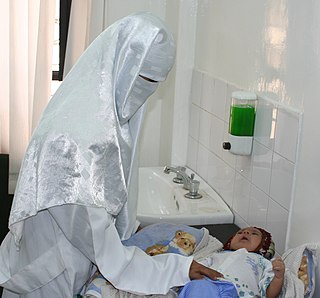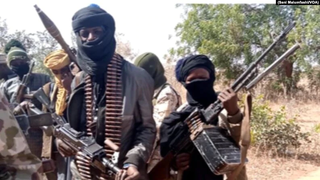Humanitarian aid workers belonging to United Nations organisations, PVOs / NGOs or the Red Cross / Red Crescent are among the list of protected persons under international humanitarian law that grant them immunity from attack by belligerent parties. However, attacks on humanitarian workers have occasionally occurred, and become more frequent since the 1990s and 2000s. In 2017, the Aid Worker Security Database (AWSD) documented 139 humanitarian workers killed in intentional attacks out of the estimated global population of 569,700 workers. In every year since 2013, more than 100 humanitarian workers were killed. This is attributed to a number of factors, including the increasing number of humanitarian workers deployed, the increasingly unstable environments in which they work, and the erosion of the perception of neutrality and independence. In 2012 road travel was seen to be the most dangerous context, with kidnappings of aid workers quadrupling in the last decade, reaching more aid workers victims than any other form of attack.

Adamawa State is a state in the North-East geopolitical zone of Nigeria. It is bordered by Borno to the northwest, Gombe to the west for 95 km, and Taraba to the southwest for about 366 km, while its eastern border forms part of the national border with Cameroon across the Atlantica Mountains for about 712 km. The state takes its name from the historic emirate of Adamawa, with the emirate's old capital of Yola now serving as the capital city of Adamawa state. The state is one of the most heterogeneous in Nigeria, having over 100 indigenous ethnic groups. It was formed in 1991 by the General Ibrahim Badamsi Babangida military regime, when the former Gongola state was divided into Adamawa and Taraba states. Since then, Adamawa State has had ten military and civilian governors.

The United Nations Office for the Coordination of Humanitarian Affairs (OCHA) is a United Nations (UN) body established in December 1991 by the General Assembly to strengthen the international response to complex emergencies and natural disasters. It is the successor to the Office of the United Nations Disaster Relief Coordinator (UNDRO).

Yobe is a state located in northeastern Nigeria. A mainly agricultural state, it was created on 27 August 1991. Yobe State was carved out of Borno State. The capital of Yobe State is Damaturu, and its largest city by population is Potiskum. While by the largest by land area is Fune, Potiskum Local Government Area is a place of Farmers and marketers, the largest cattle market in Africa is located in Potiskum.

Borno State is a state in the North-East geopolitical zone of Nigeria.It is bordered by Yobe to the west for about 421 km, Gombe to the southwest for 93 km, and Adamawa to the south while its eastern border forms part of the national border with Cameroon for about 426 km. Its northern border forms part of the national border with Niger for about 223 km, mostly across the Komadougou-Yobe River, and its northeastern border forms all of the national border with Chad for 85 km ,.It is the only Nigerian state to border up to three countries. It takes its name from the historic emirate of Borno, with the emirate's old capital of Maiduguri serving as the capital city of Borno State. The state was formed in 1976 when the former North-Eastern State was broken up. It originally included the area that is now Yobe State, which became a distinct state in 1991.

Project HOPE is an international global health and humanitarian aid non-governmental organization founded in the United States in 1958. Project HOPE works in five main areas: disasters and health crises; infectious diseases; noncommunicable diseases; maternal, neonatal and child health; and health policy. The organization has been led by President and CEO Rabih Torbay since 2019.

Adamu Bello is a Nigerian politician who was Federal Minister of Agriculture and Rural Development from 2001 to 2007. He also headed the consolidated Ministry of Agriculture and Water Resources from January to May 2007.

Modupe Ozolua is a Lebanese-Nigerian-American philanthropist and entrepreneur. She was the CEO of Body Enhancement Ltd and is the founding president of Empower 54 Project Initiatives formerly known as Body Enhancement Annual Reconstructive Surgery (BEARS) Foundation.

Despite the significant progress Yemen has made to expand and improve its health care system over the past decade, the system remains severely underdeveloped. Total expenditures on health care in 2002 constituted 3.7 percent of gross domestic product.
Michika (Mwe-cika) is a town and Local Government Area in Adamawa State, Nigeria, it is the administrative headquarters of the local government. It is in Northern Adamawa State and located directly across the border from the famous tourist site of Mcedigyi in vecemwe Rhumsiki in Cameroon. Mwe-cika (Michika) is the fourth largest town in Adamawa State.
Mohammed Buba Marwa, is a retired Nigerian army brigadier general, who is serving as the Chairman of the National Drug Law Enforcement Agency (NDLEA) since January 2021. He previously served as governor of Lagos State from 1996 to 1999 during the military regime of General Sani Abacha and Abdulsalami Abubakar and governor of Borno State from 1990 to 1992 during the military regime of General Ibrahim Babangida.

The Boko Haram insurgency began in July 2009, when the militant Islamist and jihadist rebel group Boko Haram started an armed rebellion against the government of Nigeria. The conflict is taking place within the context of long-standing issues of religious violence between Nigeria's Muslim and Christian communities, and the insurgents' ultimate aim is to establish an Islamic state in the region.
Global Medical Aid is a Danish humanitarian non-governmental charity organization, founded in 2010 by Hans-Frederik Dydensborg, Advocate of the Supreme Court (Denmark), who in 2012 was nominated to Hero of the Year by the Danish newspaper Jyllands-Posten. All members of GMA work on a voluntary basis.

The January 2014 Northern Nigeria attacks were a set of terrorist massacres that occurred in January 2014 at Kawuri, Borno state and in Chakawa village, Madagali Local Government Area, Adamawa State respectively. All of the attacks have been blamed on Boko Haram.
The Armed Conflict Location & Event Data Project (ACLED) is a non-governmental organization specializing in disaggregated conflict data collection, analysis, and crisis mapping. ACLED codes the dates, actors, locations, fatalities, and types of all reported political violence and demonstration events around the world in real time. As of 2022, ACLED has recorded more than 1.3 million individual events globally. In addition to data collection, the ACLED team conducts analysis to describe, explore, and test conflict scenarios, with analysis made freely available to the public for non-commercial use.

War crimes and human rights violations, committed by all warring parties, have been widespread throughout the Yemeni civil war. This includes the two main groups involved in the ongoing conflict: forces loyal to the current Yemeni president, Abdrabbuh Mansur Hadi, and Houthis and other forces supporting Ali Abdullah Saleh, the former Yemeni president. Al-Qaeda in the Arabian Peninsula and the Islamic State of Iraq and the Levant have also carried out attacks in Yemen. The Saudi-led coalition, backed by the United States and other nations, has also been accused of violating human rights and breaking international law, especially in regards to airstrikes that repeatedly hit civilian targets.

An outbreak of cholera began in Yemen in October 2016. The outbreak peaked in 2017 with over 2,000 reported deaths in that year alone. In 2017 and 2019, war-torn Yemen accounted for 84% and 93% of all cholera cases in the world, with children constituting the majority of reported cases. As of November 2021, there have been more than 2.5 million cases reported, and more than 4,000 people have died in the Yemen cholera outbreak, which the United Nations deemed the worst humanitarian crisis in the world at that time. However, the outbreak has substantially decreased by 2021, with a successful vaccination program implemented and only 5,676 suspected cases with two deaths reported between January 1 and March 6 of 2021.
Emergency medicine reform in Ukraine has been part of Ukraine's healthcare reform program since its launch in 2016. Managed by the Ministry of Healthcare of Ukraine, the program is meant to improve the quality and speed of Ukraine's emergency medical care.

Cyclonic Storm Sagar was the strongest tropical cyclone to make landfall in Somalia and Somaliland in recorded history until Gati in 2020, and the first named cyclone of the 2018 North Indian Ocean cyclone season. Forming on May 16 east of the Guardafui Channel, Sagar intensified into a cyclonic storm on the next day, as it gradually organized. The storm turned to the west-southwest and traversed the entirety of the Gulf of Aden, making landfall over Somaliland on May 19, farther west than any other storm on record in the North Indian Ocean. Sagar weakened into a remnant low on May 20.
The following is a timeline of the Yemeni humanitarian crisis, ongoing since the mid-2010s.












